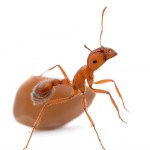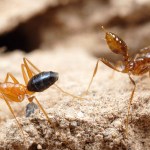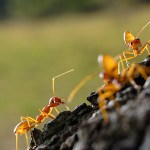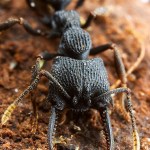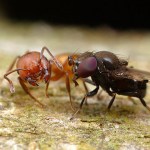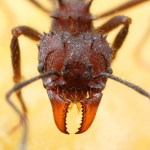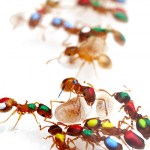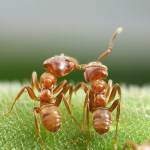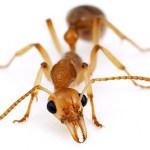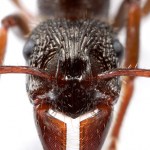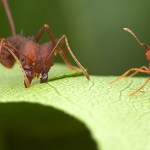ants
Well. A month has flown by, the lease is up, and the SB landlord is banging on the door to get the keys back. Something about an explosive new tenant needing the place. Supposed to be a blast.
So here it is. My final Photo Synthesis post, fitting in one last ant before the blog really takes off. Can I stop with the rocket humor already? No. I can't. There's simply too much fuel to change trajectory. (Help! Make it stop!)
In any case, it's been a pleasure participating in the ScienceBlogs community. I thank you all for reading, commenting, lurking, and sending all the emails and…
Although these two ants in northern Argentina look like they're ignoring each other, they are in fact doing just the opposite. This end-to-end confrontation is an intense chemical duel. What's particularly interesting about the image is the juxtaposition of two different defense systems.
At left is Forelius nigriventris, a speedy little insect armed with a nozzle at the tip of the abdomen that releases a chemical cocktail into the air. The Forelius colony discovered a breach in the mound of a neighboring fire ant Solenopsis invicta and has recruited hundreds of workers to pilfer the tasty…
Oecophylla longinoda - Weaver Ants
St. Lucia, Kwazulu-Natal, South Africa
Technical details:
Lens: Canon 35mm f2.0 lens on a 12mm extension tube
Body: Canon EOS 20D dSLR
Flash: Canon MT-24EX twin flash, hand-held for backlighting.
Settings: ISO 400, f/13, 1/160 sec
We recognise dead people by the absence of signals that indicate life - movement, responsiveness, pulses, brain activity, and so on. The Argentine ant does the same, but its signal is a chemical one. Throughout its life, an ant uses chemicals in its skin to automatically send out a message to its nest-mates, saying "I'm alive. Don't throw me out." When it dies, these "chemicals of life" fade away, and their bodies are evicted.
Social insects like ants and honeybees are fastidious about their colony's tidiness. If any individuals die, they're quickly removed and thrown away in one of the…
A few days ago I noticed the search term "Malagasy Mystery Ant" showing up in the stats for my other blog. This puzzled me, as it wasn't a phrase I was familiar with. So I googled it.
All mentions of the term trace back to a caption in the New York Times slide show from last week. Goodness. I- your humble blogger- had coined it myself, in a haze of deadline fever while submitting images for the slide show. And then, apparently, I forgot all about it.
Mystrium oberthueri
Am I going senile already? I hope not.
The problem with insects is their sheer number. There are millions of…
Benoit Guenard has been hard at work the past couple years compiling broad-scale distribution data for all the world's ants, and his efforts are now online. Here they are- global range maps for all the ant genera:
http://www.antmacroecology.org/ant_genera/index.html
These maps will be a very useful resource, especially if the myrmecological community participates to add new records and vet the occasional error.
One thought, though, is that large umbrella strategies such as this will eventually be redundant with antweb.org. Â Antweb's distributions are built from accumulated…
It has long been known that ants recognize their deceased nestmates using the smell of fatty acids that accumulate as the body decomposes. The chemical signature of deadness helps ants remove the corpses from their midst, keeping a clean and sanitary nest. Indeed, this classic tale of ants and oleic acid is one of E. O. Wilson's favorite stories.
But it turns out that the story is even richer than previously supposed. A study by Dong-Hwan Choe et al published in yesterday's PNAS note that Argentine ants (Linepithema humile) carry away the dead even before the fatty acids appear…
A Crematogaster ant is held up by a kleptoparasitic Milichia patrizii ant-mugging fly.
Last July, while wandering about the coastal forests of St. Lucia in eastern South Africa, I happened across an intriguing scene half-way up a spiny Acacia trunk. Some diminutive gray flies were pestering a trail of ants as they walked along the tree.
The flies' exact activities were hard to observe with the naked eye, but it looked like nothing I'd ever seen. They seemed to be grabbing ants, pinning them to the trunk, and after a few seconds letting them go again.
The macro lens on my camera serves as…
..over at Photo Synthesis:
How to attract an entomologist
Agrarian ants
Another way to humanize an insect photo
Ants in the New York Times
Photo technique: the white box
Humanizing the hordes: Anthropomorphism and science photography
Today, Roche announced funding for over a dozen genomes of organisms associated with the agricultural attine ants and the fungus they cultivate. In honor of the occasion, here's a sampling of a few of the attine species and their gardens.
Acromyrmex sp. nr. crassispinus, Argentina.
The fungus of the texan species Mycetosoritis hartmanni is grown on a substrate of caterpillar frass. Not all the attines are leaf-cutters!
Acromyrmex lundii, Argentina.
Apterostigma auriculatum, Panama.
Atta texana, Texas.
Cyphomyrmex wheeleri, Arizona.
Trachymyrmex pomonae, Arizona.
The…
Atta cephalotes, in the fungus garden
Big ant news today! Roche Applied Sciences is apparently funding the sequencing of a series of genomes- three ant and an array of fungal and microbial genomes- in an ambitious project to better understand the relationships among the players in the celebrated ant-fungus relationship. The sequencing project is headed by Nicole Gerardo of Emory University and Cameron Currie of the University of Wisconsin.
This trend in genomics away from sequencing isolated organisms in favor of comparative projects is a welcome one. With multiple…
Temnothorax marked for studies of individual behavior at the University of Arizona
Today's New York Times is carrying a profile of myrmecologist Anna Dornhaus. It is nice to see Anna's work receiving such attention, great and important, blah blah blah, but the really important part is this. The editors had the excellent taste to illustrate their piece with some ant and bee photographs of mine.
The online edition also hosts an ant slide show to accompany the story. The Times trimmed the 22 photos I suggested down to an efficient 15, but I've preserved the director's cut here. For…
My profound apologies for the lack of blogitude here while I'm over at Photo Synthesis. Fortunately, the internet has other things in it:
Myrmician shares an action series of Australian Podomyrma taking apart a much larger Myrmecia.
Brian Valentine finds some British Myrmica with a serious mite problem.
Steve Shattuck's Ants of Australia has been given an overhaul and a new URL.
Roberto Keller explains ant mouths.
Adrian Thysse has quite a nice photo blog, voyages about my camera.
***update*** There's also this bit in the New York Times. Who is that dashing young photographer?
Pogonomyrmex micans, Santiago del Estero, Argentina
Ants of the genus Pogonomyrmex ("Pogos") are known to myrmecologists as the classic harvester ants of North American deserts. They are conspicuous insects, the most noticeable of the desert ants, and something of a model organism for studies of ecology. Numerous scientific papers on pogos are published each year, and one species- Pogonomyrmex californicus- is mailed to school classrooms around the country to populate those plastic ant farms.
It's easy to forget amidst the celebrated riches of North American pogos that South…
Are these two ants sharing an intimate moment?
No.
This is just one of a long series of Azteca ant-plant ants I shot while they were coming and going from their nest. The ants were running every which way, sweeping their antennae about, and I just happened to push the shutter when two of them chanced to have passed each other in an anthropomorphic arrangement.
Yet this image, no more or less representative of the ants' actual behavior than the dozens of other images in the series, generates far more attention that any of the others. This is the one people like. It taps into something in…
Those of you who haven't got an ad blocker installed have probably seen this ant floating about in a promotional banner in the ScienceBlogs sidebar:
I can't speak for how others react to this image. Most, I imagine, filter it out as yet more clutter on the screen. But for a picture of an insect it's kind of personal for me, and rather odd it to see it splattered across the ScienceBlogs. Sort of like seeing photos of one's relatives in the news, or the family dog used to advertise pet food.
To set the scene, let me explain that when I took this photo I was road-tripping across southern…
Ectatomma edentatum, Argentina
Equipment details: Canon EOS 20D, using an MP-E 65mm 1-5x lens (at 5x), lit with an MT-24EX twin flash diffused through tracing paper.
Several years ago, before I became serious about photography, I shot the same species in Paraguay with a little Nikon Coolpix 995. Here's the result:
A Brazilian leafcutter ant (Atta sexdens) harvests a leaf while her little sister stands guard against an intrusive photographer.
(Incidentally, image searches for this genus return an unnerving mix of terrorists and ants.)
Photo details: Canon MP-E 65mm 1-5x macro lens on a Canon EOS 20D. ISO 100, f/13, 1/250 sec, twin flash diffused through tracing paper.
